Menu
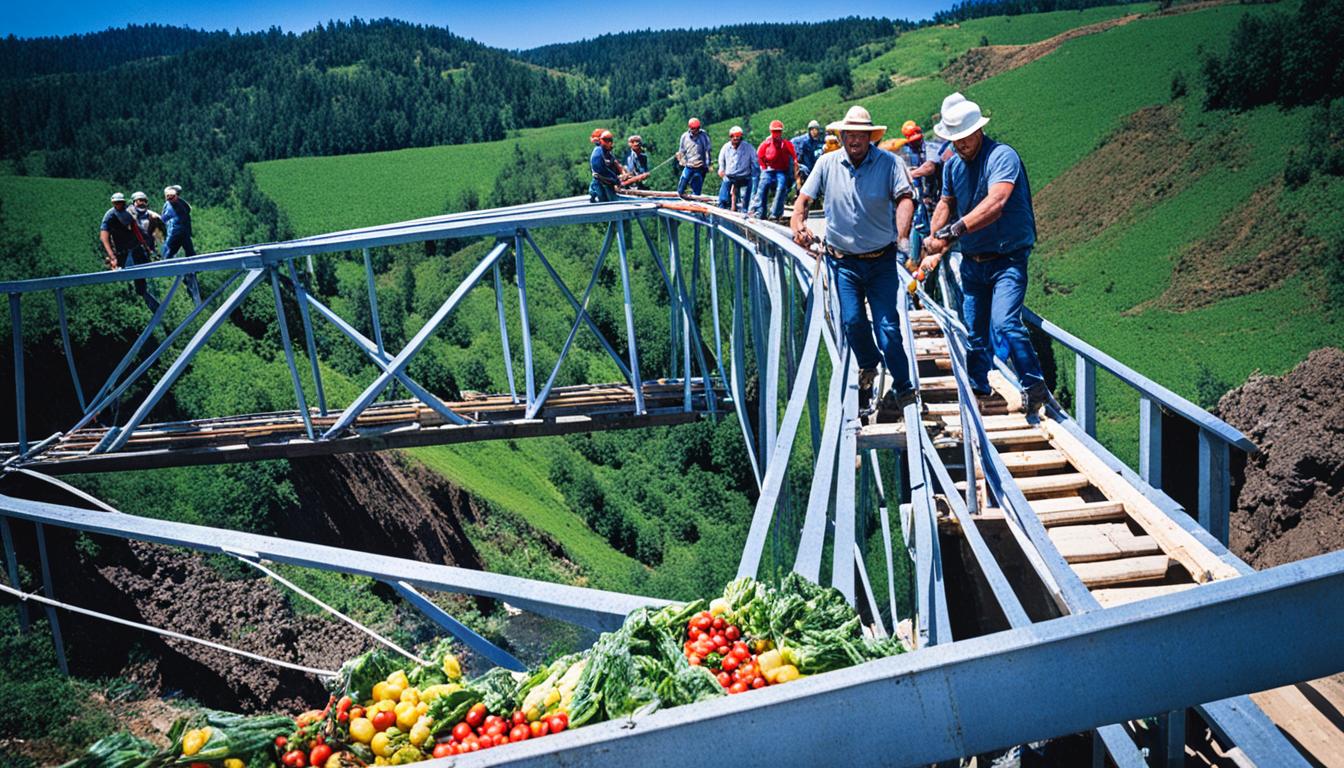
In 2019, U.S. farmers covered 91.7 million acres with corn. This massive corn farming shows why we need efficient logistics in agriculture. To make sure farm products get to consumers fast and fresh, we must streamline how they travel. The role of logistics management in agriculture is crucial. It covers everything from making to delivering goods.
The Kisan Rath mobile app in India is a great example. It shows how tech can link farmers to transport. This makes everything work better, cutting costs, and improving how people and resources are used. The right logistics methods help get products to customers on time and at lower costs. It also encourages using eco-friendly ways.
Agricultural logistics are vital. As of 2019, U.S. farmers grew corn on 91.7 million acres, per the United States Department of Agriculture (USDA). This large amount shows how essential good logistics are in farming. It covers all steps from making, storing, moving to selling farm products. This ensures things run smoothly from the farm to your table.
Efficient logistics are crucial for getting crops like corn, important for many uses, to where they’re needed fast. Good management helps fight high oil prices, thanks to corn’s use in making ethanol. It’s super important to keep things working well in food supply chains. This prevents higher costs and lower profits for farmers.
TMS is an important link in the logistics field. They work with over 20,000 reliable trucking companies to keep supply chains working smoothly. This is very important because farm and food markets change with the seasons. Their big network helps make sure goods get to where they’re needed steadily and on time.
Having an optimised food supply network is key for the farming world. It means using resources well, improving how people and businesses talk, and watching the budget. Great logistics can make or break a farm’s success. So, always looking to improve and find new ideas in this area is a must.
Here’s some data to show how important good logistics are:
| Aspect | Impact |
|---|---|
| Effective Logistics Management | Reduces operational costs and enhances coordination |
| Supply Chain Efficiency | Ensures timely delivery of crops and minimises wastage |
| Food Supply Network | Facilitates a steady supply of food products, meeting consumer demands |
To sum up, agriculture really leans on strong logistics. Focusing on good agricultural logistics, better supply chains, and a reliable food supply system is the route to ongoing success. These steps are crucial for this key industry to keep thriving.
In the world of farming, getting products from farms to markets faces many challenges. Issues include the distance, the transport used, and reaching far-off places. All of these can make moving goods tricky.
An important hurdle for farmers is cutting down on food waste. They work hard to grow plenty of food. But, getting it everywhere it’s needed without wasting any is tough. Long distances and poor transport play a big part in this problem.
This leads to food being thrown away before it’s sold. Imagine food that could have fed people just going to waste. We can use smart tools to know when we need food the most. They help send food to markets at just the right times. This way, farmers sell more and waste less.
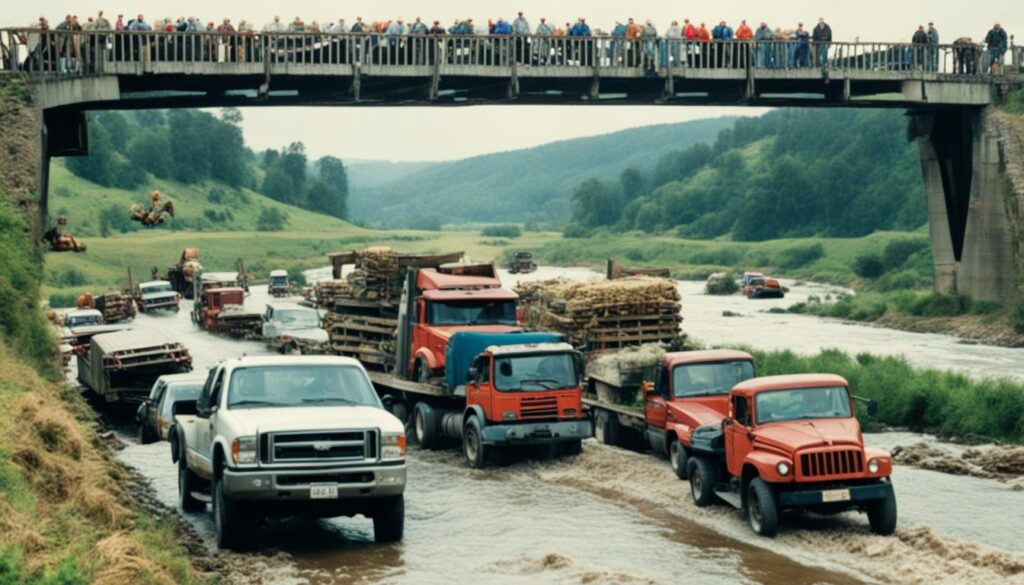
The cost of getting food from farms to you can be high. Bad transport and late deliveries hurt small farmers trying to sell their goods. But, new tech like GPS can help. It tracks food on the move, making delivery routes better and cheaper.
Planning how food gets to places is key. Smart shipment plans and using the best tech can solve a lot of problems. This makes food transport better, cheaper, and more reliable for everyone.
Today, in agriculture, using logistics technology is key for managing supply chains well. Mobile applications like Kisan Rath have changed how farmers and traders find transportation services. This makes the movement of farm products around India simpler.
The Kisan Rath app shows how mobile apps in agriculture help with logistics. It’s a place where farmers and FPOs can find transport solutions easily. This app helps cut down on losses in the supply chain. That means less food waste, lower costs, and fewer delays caused by bad logistics.
Adding GPS tracking and blockchain in supply chains has changed logistics by making them more clear and traceable. GPS lets us track shipments in real-time. Blockchain is an unchanging record that boosts trust and lessens the chances of fraud or theft. With these, routes can be improved and deliveries can be on-time. This reduces waste and makes everything more efficient.
Digital market linkage platforms directly link farmers with buyers. This cuts costs and makes the market more accessible. These platforms fix one-sided information, helping small farmers find better prices and reliable buyers. They’re a big step in working through logistic issues and making the farm-to-market path smooth.
| Technology | Advantage |
|---|---|
| Kisan Rath | Streamlines transportation services |
| GPS Tracking | Real-time shipment tracking and route optimisation |
| Blockchain | Enhances transparency and traceability |
| Digital Platforms | Improves market access and reduces costs |
Getting fresh produce to markets quickly and without spoilage is key. Mobile apps like Kisan Rath have really changed the game. They link up farmers, FPOs, traders, and transport services. These apps, along with data analysis, help us understand travel times, choose the best routes, and select the right storage. This makes managing agriculture logistics much smoother and more efficient.
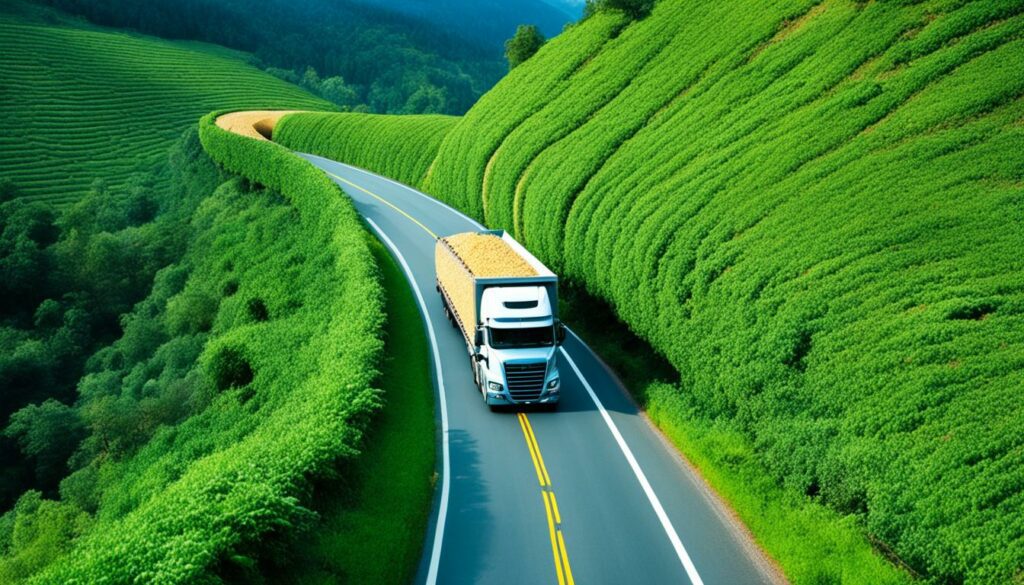
To transport goods wisely, we first look at how far they have to go. This helps pick the best way to move them. Sometimes, shipping by air, even if it’s slow, can be a lot cheaper than using the road. Adding GPS to tracking shipments gives us up-to-the-minute info. It makes things clearer, helps with coordination, and reduces harm to the environment.
Predictive analytics are also changing the game. They predict what the market will need. This helps plan production and transport better, cutting down on waste. It also means farmers can get better prices for what they sell. Cold chain logistics are crucial for keeping food cool and fresh. They help cut down waste and make more money. But making this work means having the right cool storage and transport.
Nearly 69% of small food businesses struggle with getting things from warehouse to store without damage. Clever planning can cut these problems down. The future might see more automated warehouses. These can make things smoother and cheaper for small companies, boosting their success.
| Strategy | Benefits | Implementation Examples |
|---|---|---|
| Mobile Apps | Improved connectivity and efficiency | Kisan Rath |
| Data Analytics | Enhanced decision-making | Optimised route planning |
| Predictive Analytics | Minimised waste, better market prices | Demand forecasting |
| GPS Technology | Real-time tracking, reduced environmental impact | Shipment tracking |
| Cold Chain Logistics | Preservation of perishable goods, reduced spoilage | Cold storage investment |
In recent times, the agricultural supply chain has faced many challenges. These include extreme weather, conflicts, and disease. By using data analytics, the supply chain can become more efficient.
This technology offers insights into the chain’s performance. And it helps to identify important issues that slow down progress.
Data analytics give us a full picture of the agricultural supply chain. This chain involves many parties, like input suppliers, farmers, and retailers. By studying data from every step, businesses can spot and fix what’s not working. This helps to run things smoother and use resources better.
In predicting demand, predictive analytics is very useful. It looks at past data and uses fancy math to guess what people will want. By doing this, companies can plan their production better. This leads to less wasted effort and a reduced chance of making too much. Hence, the goods are ready when needed, making everything work better.
Moreover, data analytics is good for making the supply chain more eco-friendly. It helps with managing waste, improving how goods travel, and using less harmful chemicals. All these steps make the whole process more efficient and green.
Now onwards, let’s dive into how we can improve supply chain efficiency:
| Challenges | Strategies |
|---|---|
| Weather Dependence | Invest in Controlled Environment Agriculture |
| Perishability | Sustainable Packaging; Cold Chain Logistics |
| Labor Issues | Provide Training; Use of AI and Automation |
| Sustainability Concerns | Optimise Logistics; Incentivise Sustainable Practices |
Combining predictive analytics with smart strategies is key to improving how things run. It makes the supply chain tougher against troubles. By focusing more on using data for decisions, we can keep the supply chain working well. This way, we can also meet the changing needs of those who depend on agriculture.
Cold chain logistics are crucial in our supply chains today. They’re vital for products that need specific temperatures. Recent stats show we need to keep the right temperatures throughout the supply chain. About 150 food and drinks had recalls because of dangers last year. This shows how important it is to control temperature closely.
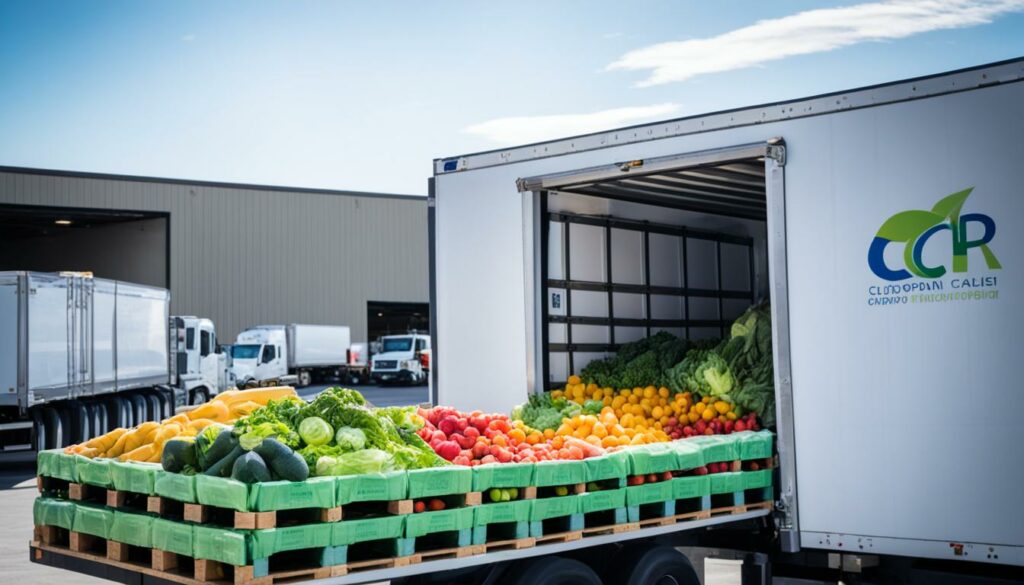
Keeping temperatures right is key for many reasons. It keeps food tasting good and healthy for us. It also stops bacteria that can make us ill. And if food goes bad because it’s too warm, companies lose money. By keeping things cold, businesses show they care about safety and quality.
Investing in cold storage is essential for fresh goods to travel safely. Many people are part of the process, from farmers to consumers. New tech like sensors and data tools make things run better. They cut waste and make shoppers happy. Things like blockchain and robots are also making food tracking more accurate.
By improving cold storage, goods reach more places. This helps sellers find new markets. Cold chain logistics are like a path from makers to buyers. They make food last longer and reduce waste on its way to the store.
Supply chain consultants are key players in agriculture. They offer custom solutions that fit the needs of farm businesses. This leads to big improvements in how well things work. The agriculture supply chain market is set to grow a lot. This is due to more use of the cloud and the need for better supply chain visibility.
There’s a big push for food safety today. This means it’s important to track food from where it starts to where it goes. Agricultural consultants work on things like managing fleets, stock, and suppliers. They make sure stuff moves smoothly. For instance, Mr.Milkman’s DMS makes order tracking and supply chain flow efficient. It cuts down on waste.
Agriculture companies deal with lots of tough issues. Things like unstable markets, not enough resources, slow tech, and hard rules. Supply chain consultants use new tech to help. They use things like smart farms, IoT sensors, and data crunching. These help farms use resources better and do things that are kind to our planet.
Working with consultants brings many benefits. Their expert knowledge helps with planning, making operations smooth, and always getting better. Real-life stories show how this support makes farming more efficient. It helps businesses use their resources well. This is key for growing smartly in farming.
Here’s a simple look at the main benefits of having supply chain consultants around:
| Key Aspect | Consultants’ Contribution |
|---|---|
| Operational Efficiency | Improved through tailored solutions and strategic planning |
| Resource Optimisation | Enhanced by leveraging precision agriculture and IoT technologies |
| Sustainability | Implemented through sustainable practices such as organic farming |
| Compliance Management | Streamlined adherence to food safety and environmental regulations |
In short, supply chain consultants are vital in helping agriculture grow better. They focus on making farming more efficient to meet new market needs and protect our planet. This makes farming able to grow more and contribute to the economy.
In the ever-evolving field of agriculture, warehousing innovations and advanced inventory management techniques have become indispensable. Embracing these innovations not only reduces wastage but also improves response to market demands.
The strategic selection of warehouse locations is critical for optimising the supply chain. Placing warehouses close to farms and markets can greatly enhance efficiency. Consultants help find the best sites, cutting down on transportation costs and enhancing delivery times.
Automated Guided Vehicles (AGVs) help make storage and retrieval faster and more accurate. They prove their value quickly by being more efficient than human workers in many tasks.
Advanced inventory techniques ensure the right stock levels are maintained. Automated Inventory Control Platforms speed up the process, reducing guesswork and wasted time. Processors and distributors gain flexibility, allowing them to respond to market changes quickly.
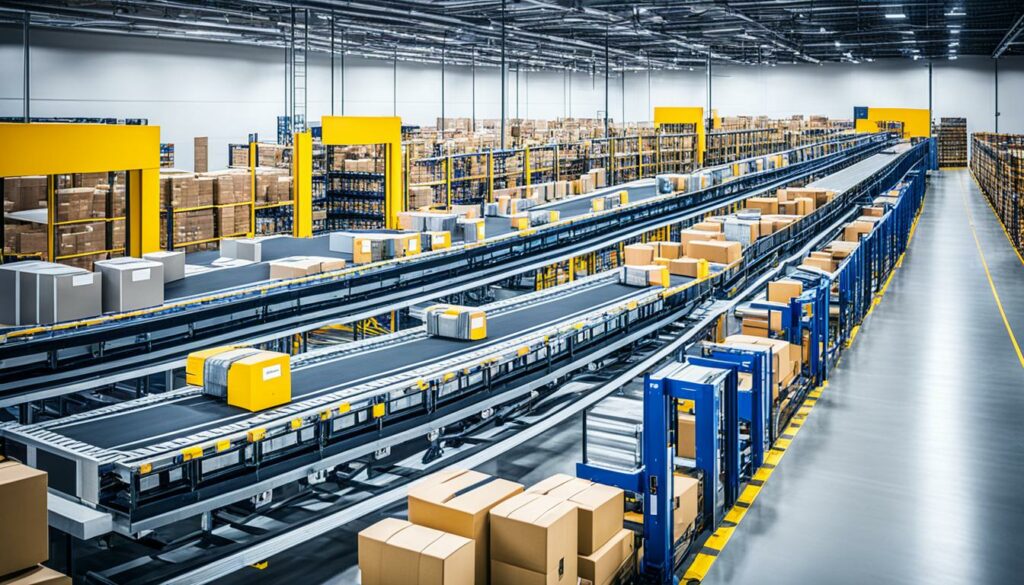
Warehouse Management Systems (WMSs) play a key role in efficient data management. They provide quick information access, helping with better planning and execution. The use of Internet of Things (IoT) technology further improves inventory and labour management, as well as customer experience through quick order fulfilment.
Collaborative robots (Cobots) and Automated Storage and Retrieval Systems (AS/RS) work with human workers to improve workflows. This makes processes faster, more affordable, and precise.
| Technology | Benefits | Impact |
|---|---|---|
| AGVs | Quicker storage and retrieval | Improved ROI and efficiency |
| Automated Inventory Control Platforms | Reduces labour and guesswork | Enhanced dynamic planning |
| WMSs | Streamlines data management | Efficient planning and execution |
| IoT Technology | Optimises inventory control | Enhanced fulfilment rates |
| Cobots | Collaborative workflow | Maintains infrastructure |
| AS/RS | Enhanced throughput and accuracy | Cost-effective and flexible |
Improving how agricultural goods are distributed needs a deep look into what the market wants. It also means finding ways to sell without many middlemen. Knowing what people want means farms can produce just the right amount without waste.
Good distribution starts with knowing what areas need. Research showed that the Northeast U.S. has many places to slaughter meat and sell it. This knowledge helps decide where and how to deliver products, saving time and money.
Using tools like predictive analytics can help farms predict what people will buy. This makes sure there’s enough of what people want. It also makes the process of getting the product to customers better and cheaper.
| WD Capacity (Tons) | Number of WDs Needed |
|---|---|
| Unlimited Capacity | 2 |
| 80 – 150 Tons | 11 – 82 |
Lessening reliance on middlemen is key to a better system. This can make things simpler and earn more money for farmers. Techniques like Amazon and Alibaba’s super docking show how a direct system can work.
Technologies like IoT and blockchain help make this change easier. In China, the use of these technologies has improved distributing fresh products. This has made the process smoother and goods more available.
By cutting out middlemen, supply chains become more direct, saving money and getting products to consumers faster. This boosts the experience for both sellers and buyers, offering fresher and cheaper goods.
In today’s agriculture, it’s key to merge automation and IoT tech. This blend achieves high efficiency and wise resource use. It also boosts productiveness while reducing harm to the environment. All these make farming more sustainable and productive.
Farm automation is a big leap in managing operations precisely. Drip systems deliver the right water amounts to plants, cutting waste. Drones watch over crops, spotting problems early for better harvests. Smart machinery with IoT predicts upkeep needs, reducing sudden machine failures.
Smartly using resources is vital for eco-friendly farming, and IoT tools are vital. They include sensors, weather checks, and smart water systems, offering real-time data. This data helps manage resources better by changing water or chemicals as needed. For instance, IoT can warn about pests early, cutting down on harmful chemicals. Also, it aids in keeping perishable goods safe during transport.
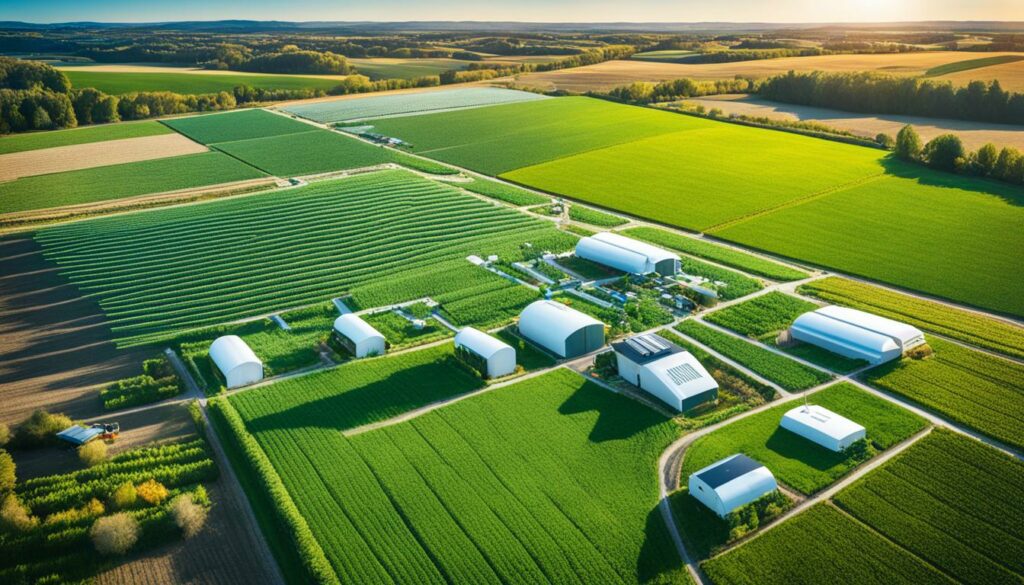
| Technology | Application | Benefits |
|---|---|---|
| Automated Irrigation Systems | Controlled water distribution | Reduces wastage, improves crop growth |
| Drones | Crop monitoring | Early disease detection, better yield |
| IoT Sensors | Soil and weather monitoring | Optimised resource usage, increased efficiency |
| Predictive Maintenance | Machinery upkeep | Prevents breakdowns, reduces downtime |
| Cold Chain Management | Temperature control during transit | Preserves quality, reduces waste |
Combining automation and IoT helps in vast ways. Besides making things more efficient, it backs eco-friendly farming. This means less waste, better crops, and higher harvests with fewer environmental downsides.
Just-in-time logistics is changing how farmers handle their supply chains. It makes sure they quickly meet market needs. This is done by using smart inventory methods, which mean less stock is needed. Farmers then adjust fast to any changes in the market.
AI and machine learning are key in this process. They help farmers know what the market will want in advance. So, production, storage, and moving of goods can be planned smartly. This way, they cut down on wasted food and can sell at better prices.
This shift to just-in-time logistics also makes supply chains more quick to respond. Products don’t sit in storage for long. As a result, fresh food quality at the market goes up. Technologies like RFID and blockchain are used. They help farmers better manage their supply chains and waste less food.
| Benefits | Outcomes |
|---|---|
| Low Inventory Levels | Reduced storage costs, increased responsiveness |
| Predictive Analytics | Better demand forecasting, minimized waste |
| RFID Technology | Improved traceability, reduced inefficiencies |
Apps such as Kisan Rath connect farmers directly with transport services. This makes just-in-time methods even more effective. Modernising agriculture this way is crucial. It helps farming stay competitive in a fast-paced market.
Controlling how goods move is key to saving money and being kind to the planet in farming. It’s all about finding ways to transport goods that meet our money needs and help the Earth. This way, we move crops and products in smart ways.
Choosing the right way to move products is a big decision. We look at things like how far they need to go, the price, their impact on nature, and how quickly they must arrive. Aircraft can be expensive, but are good for carrying quick-to-rot items. Yet, for things that weigh a lot but aren’t in a hurry, trains and boats could be better. Picking the best ways to move things not only cuts costs but also helps keep our planet green.
Making sure cost and how well things run together is tough work. It means using smart tools such as GPS, blockchain, and looking into the future with analytics. These tools help to plan the best routes and check on goods as they move. They also keep things fresh for longer. Also, connecting farmers directly with buyers through the internet makes things smoother, more profitable, and fair.
So, getting freight-moving right is vital for farming businesses to lower costs and work better. Using the latest tech and picking the best ways to transport goods really helps. It makes the farming supply chain strong and kind to our planet.
By improving farm-to-market logistics, we make supply chains work better. This means lower costs and on-time delivery of farm goods. The whole agricultural system benefits.
Logistics needs to be efficient for many reasons. It helps get products to customers on time and reduces waste. This, in turn, keeps costs down and makes the whole food supply chain more reliable.
Getting products from the farm to the market can have hurdles. These include long distances, poor transport, and hard-to-reach areas. Such challenges can cause costs to go up and delays to happen.
Food waste interferes with fighting hunger and making food sustainable. It’s crucial to cut down on losses within the supply chain. This makes delivering food better.
Apps like Kisan Rath make managing logistics easier. They link farmers with transport, find the best routes, and share info. This helps everyone involved know more and do better.
GPS and blockchain offer clear and coordinated information. This makes moving products more efficient. They work together to make transport and delivery better.
Digital platforms connect farmers directly to markets. They cut out the middlemen. This means farmers can reach customers more easily.
Good transportation planning looks at distance, mode selection, and routing. The goal is to deliver fresh goods quickly and with less spoilage.
Data analytics show how the supply chain is doing and finds places to improve. This insight helps predict what the market will need. It leads to better planning and less waste.
Keeping items at the right temperature makes them last longer and stay safe to eat. This is essential in moving food from place to place.
Investing in good cold storage is crucial. It keeps products in the best condition and supports getting goods where they need to go.
Consultants help by designing custom plans, improving routes, and picking the best places for warehouses. This all makes the supply chain work better.
Choosing the right warehouse spots, near farms and markets, is key. This cuts transport costs and speeds up getting products to customers.
Advanced inventory tools ensure there’s enough product without overdoing it. This lessens waste and makes the supply chain more responsive to what the market needs.
Working without middlemen makes getting goods to market smoother and cheaper. It also means farmers can sell their products for fair prices.
Using tech for irrigation, monitoring crops from the sky, and smart machines makes better use of resources. It also cuts down on labour costs and makes managing crops easier.
IoT tracks and collects data, leading to smarter decisions. This helps manage resources better and farm more efficiently.
Just-In-Time means keeping stock low but ready to go. This strategy is important for quickly meeting market changes.
Finding the right freight solutions, balancing cost with efficiency, is key. It must also consider how it impacts the environment.